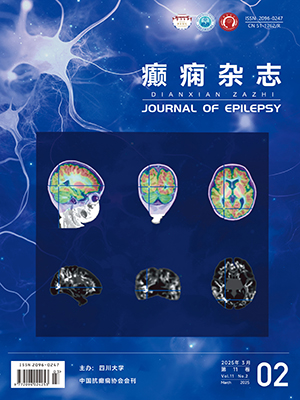| 1. |
Rei E, Juan B, Imad N, et al. Combining stereo-electroencephalography and subdural electrodes in the diagnosis and treatment of medically intractable epilepsy. Journal of Clinical Neuroscience, 2014, 21(7):1441-1445.
|
| 2. |
Delev D, Send K, Malter M, et al. The role of subdural interhemispheric electrodes (IHE) in the presurgical evaluation of epilepsy patients. World Neurosurgery, 2015, 7(34):1010-1016.
|
| 3. |
Mehta AD, Labar D, Dean A, et al. Frameless stereotactic placement of depth electrodes in epilepsy surgery. J Neurosurg, 2005, 102(31):1040-1045.
|
| 4. |
Bararo NM. Stereoelectroencephalography using computerized tomography-or magnetic resonance imaging-guided electrode implantation. J Neurosurg, 2006, 104(40):480-482.
|
| 5. |
Centeno RS, Yacubian EM, Caboclo LO, et al. Intracranial depth electrodes implantation in the era of image-guided surgery. Arq Neuropsiquiatr, 2011, 69(20):693-698.
|
| 6. |
Cossu M, Cardinale F, Castana L, et al.Stereo-EEG in children. Childs Nerv Syst, 2006, 22(8):766-778.
|
| 7. |
Arya R, Mangano FT, Horn PS, et al. Adverse events related to extraoperative invasive EEG monitoring with subdural grid electrodes:a systematic review and meta-analysis. Epilepsia, 2013, 54(16):828-839.
|
| 8. |
Nair DR, Burgess R, McIntyre CC, et al. Chronic subdural electrodes in the management of epilepsy. Clin Neurophysiol, 2008, 119(36):11-28.
|
| 9. |
McGonigal A, Bartolomei F, Regis J, et al. Stereoelectroencephalography in presurgical assessment of MRI-negative epilepsy. Brain, 2007, 130(30):3169-3183.
|
| 10. |
MacDougall KW, Burneo JG, McLachlan RS, et al. Outcome of epilepsy surgery in patients investigated with subdural electrodes. Epilepsy Res, 2009, 85(12):235-242.
|
| 11. |
Dylgjeri S, Taussig D, Chipaux M, et al. Insular and insulo-opercular epilepsy in childhood:An SEEG study. Seizure, 2014, 23(8):300-308.
|
| 12. |
Cossu M, Cardinale F, Colombo N, et al. Stereoelectroencephalography in the presurgical evaluation of children with drug-resistant focal epilepsy. J Neurosurg, 2005, 103(31):333-343.
|
| 13. |
Varotto G, Tassi L, Franceschetti S, et al. Epileptogenic networks of typeⅡfocal cortical dysplasia:A stereo-EEG study. NeuroImage, 2012, 61(12):591-598.
|
| 14. |
Murphy MA, O'Brien TJ, Cook MJ. Insertion of depth electrodes with or without subdural grids using frameless stereotactic guidance systems--technique and outcome. Br J Neurosurg, 2002, 16(9):119-125.
|
| 15. |
Vadera S, Mullin J, Bulacio J, et al. Stereoelectroencephalography following subdural grid placement for difficult to localize epilepsy. Neurosurgery, 2013, 72(10):723-729.
|
| 16. |
McGonigal A, Gavaret M, Da Fonseca AT, et al. MRI-negative prefrontal epilepsy due to cortical dysplasia explored by stereoelectroencephalography (SEEG). Epileptic Disord, 2008, 10(8):330-338.
|
| 17. |
Lee WS, Lee JK, Lee SA, et al. Complications and results of subdural grid electrode implantation in epilepsy surgery. Surgical Neurology, 2000, 54(4):346-351.
|
| 18. |
Van Gompel JJ, Worrell GA, Bell ML, et al. Intracranial electroencephalography with subdural grid electrodes:techniques, complications, and outcomes. Neurosurgery, 2008, 63(20):496-505.
|
| 19. |
Wong CH, Birkett J, Byth K, et al. Risk factors for complications during intracranial electrode recording in presurgical evaluation of drug resistant partial epilepsy. Acta Neurochirurgica, 2009, 151(22):37-50.
|
| 20. |
Wiggins GC, Elisevich K, Smith BJ, et al. Morbidity and infection in combined subdural grid and strip electrode investigation for intractable epilepsy. Epilepsy Res, 1999, 37(10):73-80.
|
| 21. |
Sperling MR. Clinical challenges in invasive monitoring in epilepsy surgery. Epilepsia, 1997, 38(12):6-12.
|
| 22. |
De Almeida AN, Olivier A, Quesney F, et al. Efficacy of and morbidity associated with stereoelectroencephalography using computerized tomography or magnetic resonance imaging-guided electrode implantation. J Neurosurg, 2006, 104(44):483-487.
|
| 23. |
Cardinale F, Cossu M, Castana L, et al. Stereoelectroencephalography:surgical methodology, safety, and stereotactic application accuracy in 500 procedures. Neurosurgery, 2013, 72(20):353-366.
|
| 24. |
Guenot M, Isnard J, Ryvlin P, et al. Neurophysiological monitoring for epilepsy surgery:the Talairach SEEG method. StereoElectroEncephaloGraphy. Indications, results, complications and therapeutic applications in a series of 100 consecutive cases. Stereotact Funct Neurosurg, 2001, 77(21):29-32.
|
| 25. |
Serra C, Huppertz HJ, Kockro RA. Rapid and accurate anatomical localization of implanted subdural electrodes in a virtual reality environment. J Neurol Surg A Cent Eur Neurosurg, 2013, 74(20):175-182.
|
| 26. |
Widmann G, Schullian P, Ortler M, et al. Frameless stereotactic targeting devices:technical features, targeting errors and clinical results. Int J Med Robot, 2012, 8(2):1-16.
|
| 27. |
Kahane P, Landre E, Minotti L, et al. The Bancaud and Talairach view on the epileptogenic zone:a working hypothesis. Epileptic Disord, 2006, 8(2):16-26.
|
| 28. |
Cossu M, Cardinale F, Castana L, et al. Stereoelectroenceph-alography in the presurgical evaluation of focal epilepsy:a retrosp-ective analysis of 215 procedures. J Neurosurgery, 2005, 57(21):706-718.
|
| 29. |
Gonzalez-Martinez J, Mullin J, Vadera S, et al. Stereotactic placement of depth electrodes in medically intractable epilepsy. J Neurosurg, 2014, 120(3):639-44.
|




